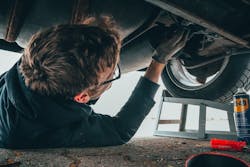Industry-wide change is not something that can be taken in all at once. Rapidly shifting technologies and the processes that bind those shifts are vast and feel more and more frequent these days.
When looking at this phenomenon in the context of a repair shop environment, it can be difficult to determine the best place to start. Preparing for the future can be a daunting task, especially when some of the most impactful changes, such as ICE vehicles becoming more obsolete, won’t be seen for several decades.
Mike Tanner, director of vehicle communications with the Auto Care Association, believes that technology offers great opportunities for shop owners, and if the industry works together there is much to look forward to.
“It’s not all doom and gloom. The aftermarket is very good at adapting,” Tanner says. “The cars must be repaired. They must be repaired on a timely and a cost-effective basis. The consumers are going to push for that. The aftermarket will adapt and do that.”
Tanner has valuable insight into this situation because he works in the emerging technologies group at ACA. This group was founded around five years ago and aims to address and assess new technologies.
Working alongside the emerging technology committee, which is made up of ACA members, the group determines what technologies are high and low risk and then performs research to establish an approach.
Two areas that the group has determined to be priorities include access to vehicle data and ADAS calibration standardization.
Tanner says that it is important to identify these areas, and it is crucial to get the aftermarket involved in the discussions that occur industry-wide because of the role it plays.
“The aftermarket has developed a fantastic ability to adapt quickly to change. They’ve shown that over decades. It’s amazing,” Tanner says. “[The aftermarket has] a unique perspective and a long history of adapting because they have to deal with what is given to them. They don’t have a lot of influence on the designs of the vehicles that are being put onto the market.”
Hearing from the aftermarket in terms of new vehicle design is especially important, Tanner says, because repair is an inevitable and overlooked part of the process.
“[The manufacturers] don’t always look at how this vehicle is going to be repaired or … how it’s going to be maintained after it’s out of warranty,” Tanner says.
In the grand scheme of things, Tanner believes that it is more efficient for the aftermarket to be in a position of influence during the initial development process rather than have to adapt to the vehicles later down the line, even though he acknowledges that adaptations are something that the aftermarket is absolutely capable of doing.
Tanner points to areas such as ADAS, which require shops to learn about different manufacturers, different procedures for implementation, and more. It can be a costly process for shops to navigate, which can lead to shops choosing to outsource ADAS calibration and repair work.
This is where access to data comes into play, which is an element that Tanner says is important to both the repair shops and the customers alike.
“The vehicle manufacturers have been saying for years that the vehicle is basically a computer on wheels … if that’s the case, then vehicle owners are used to having control over who has access to their data that’s created by their phone or their computer. It shouldn’t change just because it’s a vehicle,” Tanner says.
Ensuring that this data can be accessed fairly is a big component of the Right to Repair movement, which continues to be a hot topic across the industry. Tanner wants to see all sectors of the automotive industry come together over these standards to make the largest impact possible.
“Our proposal is to implement standardization for secure data architecture,” Tanner says.
Tanner explains that this standardization is far-reaching as well, because as we look to the future there are still many services that the aftermarket can provide to electric vehicles and software-defined vehicles alike, such as tires, ADAS calibration, brake services, battery services, battery coolant, steering, suspension and more.
“All of those areas will still be there, and then there’s other things that we’re not even aware of yet,” Tanner says.
But at the end of the day, it all comes back to data.
“If we don’t have access to that data, there’s nothing that we’ll be able to do.” Tanner says.
There is reason to be hopeful, Tanner explains. The technology to connect vehicle data to those who are repairing it is already at play in the industry. Tanner says that, at this point, it’s about getting sectors to come together in a more collaborative way.
“All of the technology exists in the vehicle today to do that. They have hardware security modules in the vehicle that would support this,” Tanner says. “We feel like it’s just a matter of everyone getting together and agreeing on the policies and governance. But the technology is no longer an excuse for not allowing access to the aftermarket to maintenance repair data.”
When looking into the future, Tanner believes that this kind of openness to communication is vital. Discussions among industry members can be a great jumping-off point, and Tanner will have the opportunity to help conduct such a conversation at the ADAPT: Automotive Technology Summit this fall in Dallas-Fort Worth, Texas.
He will have a spot on the “Securing High-Tech Repairs” panel, during which panelists will discuss how to maintain cybersecurity for all repairers, and how to keep customer data safe.
As overwhelming as that topic may sound, Tanner wants all of the Summit attendees to know that the aftermarket is resilient, and there is plenty to look forward to.
“It’s important to remember that there are a lot of challenges out there, and the aftermarket will evolve,” Tanner says.




